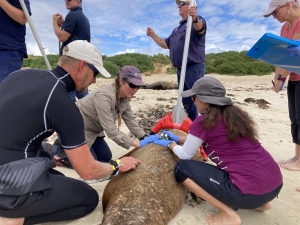Treasure trove of eco data ‘mapped’ online to help future marine heatwave response
A century of data sources on Western Australia’s sea life, including fish, invertebrates and their habitats, has been collated and made publicly available as part of an innovative project aimed at better forecasting and managing marine heatwaves.
The data sources have been used to create a public digital dashboard within an online StoryMap site to allow scientists and the community access to the valuable information using interactive maps and text.
Professor Kathryn McMahon from Edith Cowan University’s (ECU) School of Science, who is a co-lead on the project’s ecological impact theme, said there had been a focus on getting as much information as possible from almost 20 organisations to help researchers understand the ongoing impact of marine heatwaves on sea life.
“By collating this data, we can use it to see patterns and trends that emerge, which can contribute to understanding changes to fisheries abundance and distribution.” Professor McMahon said.
“They cause fish and seagrass to die, and some species migrate to new areas and there are huge ramifications for the ecology, fisheries and tourism.”
“This data mapping project has the practical application of helping to predict what will happen in the future so we can better manage these destructive events.”
Theme co-lead Dr Sharyn Hickey from The University of Western Australia’s School of Agriculture and Environment said users of the system would be able to search specific regions to find out more about local species and available data sources.
“By bringing this together it also helps researchers collaborate on projects by identifying who has gathered the information,” Dr Hickey said.
“This product is a big step forward in helping us understand how marine heatwaves, which are increasing along our western Australian coastline, may be affecting our marine ecosystems,” Dr Hickey said.
“More work is needed to develop appropriate responses for these extreme events.”
Data from the project is expected to be used as a reference for future research to assess trends in species’ abundance and distribution.
This initiative is part of the ‘Advancing predictions of WA marine heatwaves and impacts on marine ecosystems’ program, which is managed by the Western Australian Marine Science Institution (WAMSI).
Program scientists come from organisations including the Bureau of Meteorology, Curtin University, Department of Biodiversity, Conservation and Attractions, Department of Primary Industries and Regional Development, Edith Cowan University, Murdoch University and The University of Western Australia.
The StoryMap can be found at: https://arcg.is/1LvKXn0

